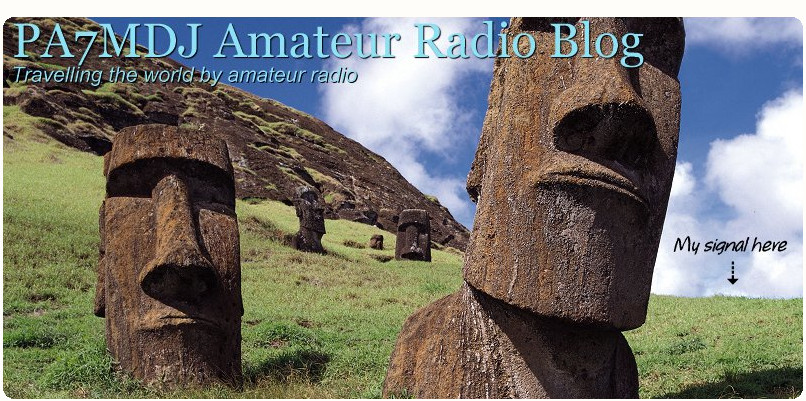Here's a photo of my current WSPR / QRSS MEPT* setup in the attic.
From left to right:
- Magnetic loop tuner (QRP only, max approximately 10 watts) and magnetic loop antenna
- 5V 8000mAh powerbank
- Voltmeter
- 200 mW U3S QRSS / WSPR transmitter with QLG1 GPS receiver in the same housing (both homebuilt from a QRP Labs kit)
On the back of the table is a wooden box to store the various Low Pass Filters for the U3S. I've built my U3S without the relay-switched LPF board, so when changing band I have to swap the LPF manually.
The loop tuner holds a magnetic loop antenna made of a wooden support and RG-213 coax cable. The loop has a 5 metre circumference (radius = 5/2π = 0.8 m). Both the loop and loop tuner are homebrew. The mag loop can be tuned for the 80, 60, 40 or 30m band. The big size of the loop guarantees a relatively good efficiency on the lower bands (which I was aiming for while designing it), but means that I can not get it tuned on the higher bands. In the future I might make a second smaller loop that can also be used on at least the 20m band. The mag loop and tuner are not weatherproof and will be placed inside in the attic only, or maybe every now and then outside on a beautiful summer night.
I've only just recently built the magnetic loop antenna, and I've been experimenting with it mainly on 40m WSPR. It really works great, especially considering that it's placed inside in an antenna-unfriendly environment (concrete walls on two sides, several other antennas and metal structures nearby).
The past couple of days on 40m WSPR with the loop and the 200mW U3S I've been spotted all over Europe, by several stations in the United States (including N5CEY on the Mexican border in Texas), VP9NI on Bermuda, and 9L/KW4XJ in Sierra Leone. Looking at the results I would say the loop is at least performing equally well to the outdoor loaded EFHW sloper wire antenna that I was previously using for my MEPT setup, maybe even better.
 |
| Some of the 40m WSPR spots of the past few days sorted by distance |
Over time I will be optimizing the mag loop. I'm looking for a way to make tuning easier. Now I use my Yaesu FT-817 to tune for maximum noise on receive nearby the WSPR/QRSS frequency I want to use, and then fine tune until the rig's built-in SWR meter shows no bars anymore on transmit. I then connect the U3S.
I'm looking into a way to tune the mag loop without the help of the FT-817. In the future I would like to experiment with tuning methods used by other mag loop users. This includes a small NE-2 type neon lamp that at maximum brightness indicates maximum antenna current, or measuring for maximum RF voltage across the capacitor plates. I'll have to do some more online research into both.
I will be participating with the MEPT setup as it is now and as described above in the "Night of QRSS" New Year's Operation Celebration of the Las Cruces QRSS Mafia. More information can be found here and here. The event has generated quite some interest on the QRP Labs group recently.
Below I will post some links to interesting QRSS websites that I've recently found.
* MEPT = Manned Experimental Propagation Transmitter
See also:
http://www.zianet.com/dhassall/BILLIONMPW.html
http://dropbox.curry.com/docs/2012_The_world_of_QRSS.pdf
http://www.zianet.com/dhassall/QRSS_A.html
http://swharden.com/qrss/plus/
https://sites.google.com/site/g7aqkhamradio/home/my-qrss-beacon











No comments:
Post a Comment